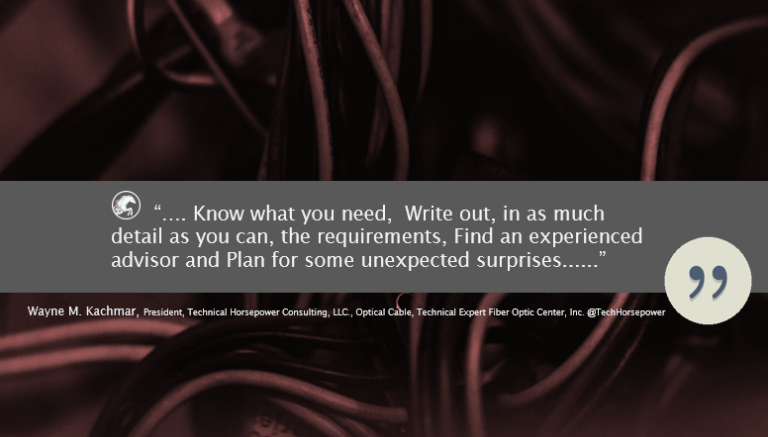Many times I have had the conversation about how to get started in cable manufacture or get a new extrusion line up quickly. Invariably two questions come up:
- How quick can I be in production and what equipment do I need?
That quickly is followed by,
- How much will it cost and how can I get it quicker?
So as a result we are soon discussing used vs. new process equipment.
New equipment
New equipment typically has long lead times and at a system level is expensive. There are many used equipment dealers who have a variety of used equipment and services to integrate new process controllers or computerized process control upgrades to used or refurbished equipment. They typically can engineer to customer requirements and the long lead time items such as extruders, capstans etc. are in house ready to be refurbished or are already refurbished at the component level. This means that they can deliver a workable product at much reduced lead times and usually at less cost than a completely new line.
So on the surface one would ask the question,” why would anyone buy new?”. There are several answers to that question.
First, many new lines are engineered to a specific product family and come with a product start-up guarantee and final payment occurs when they produce a first article cable at the line installed at the customer’s site. This can take a long time from contract to final acceptance. (In some cases longer than a year.)
Second, in many cases the customer does not have a deep knowledge of optical cable manufacture of the type being requested. (I.e. a copper cable manufacturer may want to add a fiber optic loose tube product line). As a result, relies on the process line manufacturer’s expertise in this specific area.
Third, the manufacturer may want a duplicate line to existing lines in their plant to simplify operations and maintenance. This is typical of larger companies like a UPS only using one brand of van for delivery.
Used or refurbished equipment
So when would someone want to used or refurbished equipment? Many times it relates to a new product line that has been identified and specific requirements as to timing of market entry or market demand that require a quicker turnaround of capital expenditure to production. In these cases, the customer may specify only generic requirements and the used / refurbished supplier may have the components ready or nearly ready to start the system integration.
This works best when the cable manufacturer has solid knowledge and experience of what they want in such a process line. They may in fact purchase the line in generic form and add / integrate fiber cable specific components or tooling themselves.
Another reason to use a used refurbished process line is reduce costs as well as speed to market. In many cases the customer gets top of the line components at substantial discount to newly ordered components.
While many components such as the extruder and water troughs are generic in nature, many problems occur when fiber specific components are not matched to the line or use they are expected to perform. One big issue to consider is that while many existing components in the used vendors inventory may appear to be a fit, much of the equipment may be beta or truly experimental versions of components that may not have worked out as planned.

Over the years perspective
Over the years, I have seen some very sophisticated fiber payoffs and capstans that were truly concepts but performed so poorly that they were replaced as soon as a more orthodox component was available. I have also seen some of the best functioning equipment in the used refurbished inventories at very reasonable prices. So how to tell the difference, and is it that black and white? The answer seems to be in gathering the most experience in both equipment purchasing and process line configuration.
In some cases the equipment may be able to be upgraded to present state of the art standards with a small outlay and some deeper technical knowledge.
I have reconfigured process lines and made small modifications that created excellent purpose built optical cable process lines. I have learned from much practical experience when the configuration is, “a bridge too far”. Knowing when to call a line configuration too much of a kludge is very valuable. The areas that seem to be passed over the most are a clear definition of what the process line is expected to do (i.e. multiple changes, micro cables, loose tube, etc.). Additionally, how the line will be integrated into the manufacturing environment. It is clear that you cannot optimize a process line to do it all.
In some cases, the best approach is to hire outside technical support to help guide and educate in-house staff who already have a full plate of engineering work. Check list: knowing what worked in the past and what was a good concept but never really was successful can save a ton of work and expense later. Mentoring of technical staff in this way allows for onsite ownership and initial familiarity with the new equipment as well as the ability to call on outside help when things change or problems occur.
Optical test equipment tip
When it comes to optical cable manufacture, I feel it is important to add that optical test equipment is sometimes as expensive as the process equipment and recently many used test equipment resellers are out there. In some cases they purchase the units as part of a large enterprise relocation of division closure and know practically nothing about the units other than they can power up and self-test.
As the recent trend has been to reduce the size and increase the portability of expensive test equipment such as OTDRs, it may literally be counter intuitive for someone looking at the picture on a web site a good and bad value.
Likely, they may not realize that some pieces of optical test equipment and some brands age better than others. There are many large OTDRs for sale that are no longer serviceable by their manufacturers and other brands that are significantly older that are extremely reliable and still serviced and calibrated by their manufacturer.
Conclusion
The bottom line to all of this is:
- Know what you need
- Write out, in as much detail as you can, the requirements
- Find an experienced advisor
- Plan for some unexpected surprises.
They are the only things you can be sure will occur.



